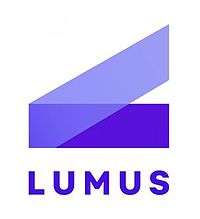Lumus
 | |
Type of site | Private |
|---|---|
| Headquarters | Ness Ziona, Israel |
| Founder(s) | Dr. Yaakov Amitai |
| CEO | Ari Grobman [1] |
| Key people | Shlomo Kalish (Chairman of the Board) |
| Industry | Augmented Reality, Consumer Electronics |
| Website |
lumusvision |
Lumus is an Israeli-based Augmented Reality company headquartered in Ness Ziona, Israel.[2] Founded in 2000 by Dr. Yaakov Amitai, Lumus has developed technology for see-through wearable displays, via its patented Light-guide Optical Element (LOE) platform to market producers of smart glasses and augmented reality eyewear. Lumus' technology enables a small natural looking form factor, wide field of view and true see-through performance.[3]
History
- 2000: Lumus was founded by Dr. Yaakov Amitai to develop and market its Light-guide Optical Element (LOE) technology for eyewear displays (see-through wearable displays).
- 2008: The company started selling the PD-18: a top-down, transparent monocular display with SVGA resolution 32 degree field of view (FoV), and full color. The PD-18 and its derivative, the PD-14, were aimed at professional and military markets.[3]
- 2010: Lumus' technology received high level validation when the US Air Force selected Gentex's Scorpion Helmet Mounted Cueing System (which employs the Lumus PD-14), with Raytheon as the primary contractor, for the HMIT program for A-10 and F-16 Aircraft.[4] This display and contract win marked the first time a full color HMD was selected for combat aviation. Subsequently, Lumus' display as part of Thales Visionix's (formerly Gentex)Helmet Mounted Cueing System has been selected for the CHMDS / Air Soldier program. Once the roll out was completed on this program, Lumus displays represented the majority of HMDs deployed in the worldwide combat aviation market.[4]
Technology
The LOE is a patented [5] optical waveguide that makes use of multiple partial reflectors embedded in a single substrate to reflect a virtual image into the eye of the wearer. Specifically, the image is coupled into the LOE by a "Pod" (micro-display projector) that sits at the edge of the waveguide—in an eyeglass configuration, this is embedded in the temple of the glasses. The image travels through total internal reflection to the multiple array of partial reflectors and are reflected to the eye. While each partial reflector shows only a portion of the image, the optics are such that the wearer sees the combined array and perceives it as a single uniform image projected at infinity. The transparent display enables a virtual image to be seamlessly overlaid over the wearer's real world view. This is especially true when the source image comprises a black background with light color wording or symbology being displayed. Black is essentially see-through color, while lighter colored objects, symbols or characters appear to float in the wearer's line of sight. Conversely, full screen images like documents, internet pages, movies which are typically brighter colors can be displayed to look like a large virtual image floating a few meter's away from the wearer.
Applications
Products
Using Lumus Optical Engines (OE) or Development Kits allows smart eyewear manufacturers to maintain their own industrial design and branding.
Optical Engines
| Product | Resolution | Thickness | Transparency | Brightness | Weight |
|---|---|---|---|---|---|
| OE-31 [9] | 720p 1280 x 720 pixels Field of View :40° | Eye motion box:10 x 8 mm | :>78% | 1,000 FtL Contrast ratio:>250:1LOE | 27gr ]] |
| OE-32 [10] | ]] | ||||
| PD-18 [11] | SVGA 800 x 600 pixels Field of View : 32° | Eye motion box: 10 x 10 mm | In active area >70%. Outside active area >92% | >1200 FL | 70gr ]] |
Development Kits
References
- ↑ "AR Technology Innovator Lumus Appoints Ari Grobman as CEO". prweb. Retrieved 28 April 2017.
- ↑ "Company Overview of Lumus Ltd". Bloomberg.
- 1 2 Glas, Kristijan (Jul 31, 2007). "Lumus – Future Video-Eyeglasses". The Future of Things.
- 1 2 Spitzer, Cary (Sep 3, 2014). Digital Avionics Handbook (Third ed.). CRC Press. p. 16-13. ISBN 9781439868980.
- ↑ "Light guide optical device". Google Patents.
- 1 2 Feist, Jonathan. "Lumus – military grade technology in Android powered smart glasses". Android Authority.
- ↑ "Opgal and Lumus present thermal camera capabilities combined with eyewear at SPIE". Opgal.com. May 5, 2014.
- ↑ Davies, Chris (Mar 21, 2012). "Lumus OE-31 wearable display hands-on". Slash Gear.
- ↑ Davies, Chris (Mar 21, 2012). "Lumus DK-40 takes on Glass with true AR". Slash Gear. Slash Gear.
- ↑ Cardinal, David (January 11, 2016). "Lumus and InfinityAR aim to do for augmented reality what Oculus has done for VR". Extremetech.
- ↑ Allen, Gavin (13 January 2012). "Email in your eye? Next-generation video screen glasses could lay messages or GPS over your field of vision". Daily Mail.
- ↑ "Lumus DK40 smartglasses are your personal HUD (hands-on)". Cnet. January 7, 2014.
- ↑ Davies, Chris (January 7, 2016). "These Lumus displays could fix HoloLens' big problem". Slash Gear. Slash Gear.
- ↑ Lee, Nicole (January 6, 2016). "Lumus wants its display optics in future smart glasses". Engadget.